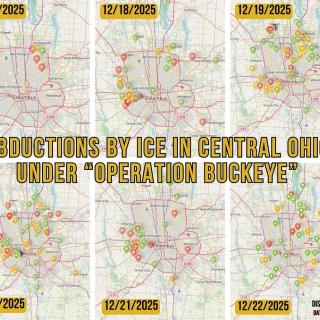Advertisement
Recently Ohio Right to Life brought a bill to the Ohio General Assembly that would change substantially the way adoptions are done in the state.
HB 307, known as the Infant Adoption Reform Bill, shortens the time that an adoption in Ohio can be challenged post-finalization, decreases the time a man is eligible to file with the Putative Father Registry, permits individuals and couples to advertise for a child to adopt and increases the Ohio adoption tax credit from $1500 to $10,000.
ORTL president Mike Gonidakis claims that these measures will reduce abortion rates and encourage adoption by relieving potential adoptive parents (popularly known in adoption reform as “paps”) from the stress and expense of a long drawn-out, often expensive, adoption process.
There is nothing in the bill, however, to indicate how making the adoption process easier and cheaper will increase newborn adoption rates since newborns are traditionally in short supply. Nor does it address how to increase the adoption of hundreds of available children warehoused in the state's over-burdened foster care system. During the first hearing, a member of the House Committee on Health and Aging asked bill sponsor Jim Buchy (R-Greenville) why the bill didn't include foster care. He replied “that's obviously a different issue.”
Framed in the language of “adoption reform,” the bill is the polar opposite of what the genuine adoption reform movement works toward—family preservation when possible, and ethical and transparent adoption procedures that protect birthparents, children and potential adoptive parents. Foster care adoption is a priority.
Adoption Challenges
At the second hearing for the bill on November 20, Lucie Blumenthal, head of adoption services at Adoption Circle in Columbus, testified before the Health and Aging Committee that in her 28 years of adoption agency experience, she has never seen a birthparent challenge an adoption post-finalization.
However, according to local attorney Erik L Smith, there have been several successful cases of post-finalization challenges in the state. Smith, who has written extensively about adoption law, says that Blumenthal failed to note that Ohio's Statute of Repose, which sets time limits on court challenges, is valid only if a birthparent has been given legal notice of the adoption petition and hearing. If notice is not received then the adoption can be voided, even years later. In a 1986 case, the st Distract Court of Appeals in Cincinnati voided an adoption four years after it had been finalized because the mother lacked notice. In the case In re Adoption of Knipper, the court ruled that the Ohio legislature does not have the constitutional power to deprive a birthparent of their parental rights without valid notice.
“This bill won't reduce challenges,” Smith says, “but even if due process has been fulfilled and notice is given, two months is too short. It eliminates birthparents with legitimate claims relief from the adoption judgment. There can be mistakes, duress, misunderstandings, fraud or a lack of due process.”
The only thing this bill will do, Smith believes, is cause more unethical adoption behavior. “The key to doing unchallenged adoptions is to do it right in the first place,” he says.
Putative Fathers
The most controversial part of the bill, however, are the changes in the Putative Father Registry.
A putative father is an alleged father who is not married to the mother. In Ohio, a married father is considered the legal father of a child and enjoys legal protections that a putative father does not. Unlike a putative father, a legal father must consent to the adoption of his child.
In the mid-1990s Ohio passed a Putative Father Registry law that requires men who believe they have fathered a child outside of marriage to register with the state's PFR during the pregnancy or within 30 days of the child's birth in order to receive legal notice if an adoption petition is filed. This registration does not stop an adoption, but guarantees the right to notice. If notice is received, the putative father has 14 days to file an objection. Otherwise the adoption can go through without his consent. The PFR is little advertised and most men don't know about it until it is too late.
HB 307 decreases the registration time frame from 30 days to seven, but also requires adoption agencies and lawyers to notify a putative father of a pending adoption relinquishment and about the PFR option. It also offers him the opportunity to sign away his parental rights pre-birth, something women, by law, cannot do in Ohio.
The catch is that a woman is not required to divulge the name of the alleged father to the adoption agency or lawyer. Agencies and lawyers, in fact, frequently advise women to leave fathers' names out in order to smooth the way for placement and to avoid interference. Besides that, a woman can claim she doesn't know the name of the father, or can give a false name and contact information about him.
She can also work around the PFR time requirement by waiting until after the time limit is expired before making an “official” adoption decision, cutting out the father altogether without the nicety of the PRF. Many of the high profile cases of birthfather-disputed adoptions today stem from women who refused to inform the father of the pregnancy, told him she miscarried or had an abortion, or the baby died. Or she can simply disappear. Unethical adoption attorneys and agencies, offering attractive financial incentives, often send women to L-D-S-affiliated adoption mills in Utah where courts disregard fathers' rights—even if the father has a court order from his home state to stop the adoption.
Susan Garner Eisenman, a local adoption attorney and a member of the American Academy of Adoption Attorneys (Quad A) told the Free Press that ORTL has cut its nose off with PFR changes by by failing to recognize the importance of the current law. At the November 20 hearing she testified that although she supported the bill as a whole she had concerns about the change to seven days, which she says courts have routinely rejected. She suggested it be amended to 14 days.
Erik Smith sees it differently. He believes any decrease in the time frame will keep responsible fathers out. He supports what he calls a “hybrid deadline” that would allow fathers to file at any time after the birth, even years later. He points out that some adoptions take place when children are older either by a standard relinquishment procedure or through a stepparent adoption. Men may lose their parental rights simply because they did not register with the PFR within 30 days of birth.
Advertising
In many states, including Ohio, advertising for a baby to adopt is illegal due to fear of financial coercion, baby buying and child trafficking. In the past year, Facebook has shut down several baby begging pages. During the first hearing, Rep. John Patrick Carney (D-Columbus) asked sponsor Buchy if he had researched the issue or contacted experts in the trafficking field for an opinion. Buchy was befuddled at first, and then answered a curt “No,” and refused to comment further.
Tax Credits
While not so controversial, the increase in the adoption tax credit in the long-run will not increase adoption rates, but it will increase adoption costs. When tax credits are available private adoption agencies and lawyers jack up their fees.
For several years, James Hamilton, a St. Paul-based attorney and father in an international adoption, has observed the relationship between adoption fees and tax credits. He recently made a study of the federal adoption tax credit, “What Does America Get for $500 Million a Year in Adoption Tax Credits?”
Hamilton writes that infant adoption is an exercise in free market economics. The demand for newborns is high, while supply is low, and cost is limited only by what the market will bear—currently about $40,0000 for a healthy newborn. By increasing the amount families are able to pay and the number of families eligible to enter the market, tax credits increase the demand without increasing the supply. “Who wins?” Hamilton asks. “Those who profit from adoptions and those adoptive families at the upper end of the economic ladder.” Tax credits, in reality, push middle and lower class families out of the newborn market ORTL claims it is building for them.
Hamilton estimates that in 2010, under the Federal adoption credit system, $500 million in taxpayer money, at a minimum, passed into the pockets of the private adoption industry through increased fees under the guise of easing the cost of adoption.
Creating a climate of adoption?
Ohio Right to Life is used to getting its way with the Ohio Legislature, but it has never delved into adoption outside of advocating it. ORTL reportedly has not sought assistance from welfare groups in the state and, as of this writing, has even refused input from Quad A, a natural ally. After a brief phone interview with ORTL legislative director Kayla Smith, the Free Press sent, at her request, a list of questions regarding the bill, but a response was never received.
In the last legislative session ORTL had several victories that makes abortion more difficult to access in Ohio. New laws include diverting Planned Parenthood funds to evangelical “crisis pregnancy centers,” requiring abortion providers to force clients to listen to fetal heartbeats and a ban on state-subsidized rape counselors discussing abortion or making abortion referrals. More roadblocks are planned.
It seems that ORTL, in creating an abortion-hostile climate, believes that relinquishment of newborns will increase to a lack of alternatives.
What ORTL fails to note, and every adoption reformer knows, is that there is little relationship between abortion and adoption. After a brief downturn in adoption after Roe, adoption numbers settled and remain steady. The stigma of unmarried pregnancy and motherhood has plummeted and nearly all unmarried mothers keep their children. Women who have abortions don't want to be pregnant; those who place babies for adoption either can't or don't want to parent.
ORTL appears to have no clear idea what it seeks to accomplish with HB 307. Dawn Friedman, a Columbus therapist who specializes in adoption issues sums it up, “I'm confused about the emphasis on domestic infant adoption since there isn't a lack of potential parents waiting to adopt newborns but there is a very real need for more placement options for older child adoption."
Ohio Right to Life, either by design or ignorance, has co-opted adoption reform for its anti-abortion agenda, but fails to show how its bill relates to that agenda. Instead of setting realistic adoption goals such a streamlining foster care placement, capping adoption fees and in increasing funds for child/mother welfare services and foster care placement, it's creating imaginary children for thwarted potential adoptive parents .



